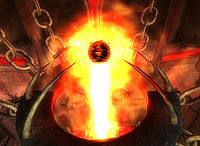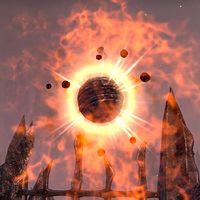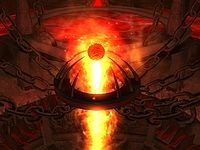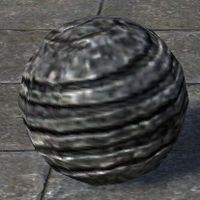Lore:Sigil Stone
A Sigil Stone is a pre-Mythic quasi-crystalline morpholith that has been transformed into an extra-dimensional artifact through the arcane inscription of a Daedric sigil, which can be used to create portals from Mundus to Oblivion.[1] They are spherical objects, and emit both a humming noise and a dark red glow. The morpholiths used to create the Sigil Stone can only occur in pocket voids of Oblivion, and harvesting them requires Daedric assistance. The cleansed morpholith must then be presented to a Daedra Lord to perform the inscription of the sigil, which will transform the specimen into a true Sigil Stone. The Daedra Lord and the mechanic of the Sigil Stone must then jointly invoke the conjurational charter, which will transport the Stone through the liminal barrier and create a temporary portal. The portal only remains open for a brief period of time, depending on the strength of the liminal barrier at the chosen location; the longest recorded time under these circumstances was only a few minutes, making this type of portal rather useless. The power of a Sigil Stone is similar to that of a filled soul gem, but much stronger,[1] to the extent that is has been said that even a thousand soul gems would likely dissolve in the presence of a Stone.[2] Many ready-made sigil stones can be found in Oblivion, and can be obtained by powerful conjurers who force an unbound Daedra into submission. Dremora are often used for this purpose, although their Lord is angered by this theft.[3]
Due to Martin Septim's sacrifice at the end of the Oblivion Crisis, the Liminal Barrier constructed by the event is too strong for even a Sigil Stone to breach for more than a fleeting moment.[4][5][2]
Uses[edit]
Although mainly used by Mehrunes Dagon, Sigil Stones are known to also be used in other realms of Oblivion such as Coldharbour.[6]
Sigil Stones have other uses apart from sustaining liminal bridges. One was used as an opposing force to a Great Welkynd Stone to open a portal to Gaiar Alata. Daedric Siege Crawlers use them as a power source. The arcane power of a Stone can be used in enchanting, consuming the Stone in the process.[7] Powerful conjurers require Sigil Stones for use in rituals to summon items and Daedra from Oblivion when using the Atronach Forge, although the Stone isn't necessary when summoning lesser objects.[3] Sigil Stones can also be used to create less permanent portals to Oblivion, which can be opened at will as long as the Stone remains intact, although this method binds the stone to a particular location in Mundus.[8]
History[edit]
During the Oblivion Crisis, the loss of the Dragonfires caused the liminal barrier to slowly weaken and allowed these liminal bridges to remain open indefinitely.[9] This was exploited by the Mythic Dawn and Mehrunes Dagon, who created Oblivion Gates to the Deadlands, allowing the Daedric forces to invade Tamriel. A method of destroying these Gates was discovered by the Hero of Kvatch at the Sack of Kvatch: removing the Sigil Stones from the well-defended keeps in the Deadlands where they were hidden would break the connection, teleporting those near the Stone back to Mundus and destroying both the Oblivion Gate and its Sigil Keep in the process. Occasionally, Gates would have multiple Sigil Stones supporting the link, and all of them would need to be removed to shut the Gate;[10] similarly, one Sigil Stone may support multiple Gates. This technique for opening portals was exploited at the Battle of Bruma by the united forces of Cyrodiil (led by Martin Septim) to procure a Great Sigil Stone, a more powerful specimen used to sustain larger portals such as the "Great Gates". Each Oblivion Gate which was opened weakened the liminal barrier, eventually completely diminishing it and allowing Mehrunes Dagon pass fully into Mundus. The barriers were restored when the Amulet of Kings was smashed, summoning the power of Akatosh to banish Dagon.[7]
The legendary Arms of Chaos were created through the use of Sigil Stones, from which they derived their power. An Orange Sigil Stone was embedded in the Arm of the Sun, and a Green Sigil Stone was affixed to the Arm of the Moon. A mage named Ellane later discovered the means by which these staves were created, and used a Blue Sigil Stone to create the Warlock's Mark, an enchanted necklace.[11] However, the stones were subsequently removed and returned to Oblivion, to be guarded by three Dremora known as the Guardians of the Sigil Stones. Circa 4E 201 the Guardians were summoned and defeated by the Last Dragonborn in order to recover the three Sigil Stones and restore the disassembled artifacts.[12]
Gallery[edit]
Notes[edit]
- Sigil Stones were featured in TES IV: Oblivion, TES Travels: Oblivion, TES V: Skyrim, and Elder Scrolls Online.
See Also[edit]
References[edit]
- ^ a b Liminal Bridges — Camilonwe of Alinor
- ^ a b Excavation Leader's Journal in Skyrim
- ^ a b Events of Skyrim
- ^ Vonos' Journal — Vonos
- ^ Martin's dialogue in Oblivion
- ^ Moonhenge's Tear quest in ESO
- ^ a b Events of Oblivion
- ^ A Change of Heart quest in ESO
- ^ Martin Septim's dialogue in Oblivion
- ^ Events of Oblivion Mobile
- ^ Hyenril's Journal — Hyenril
- ^ Arms of Chaos Creation for Skyrim Special Edition








